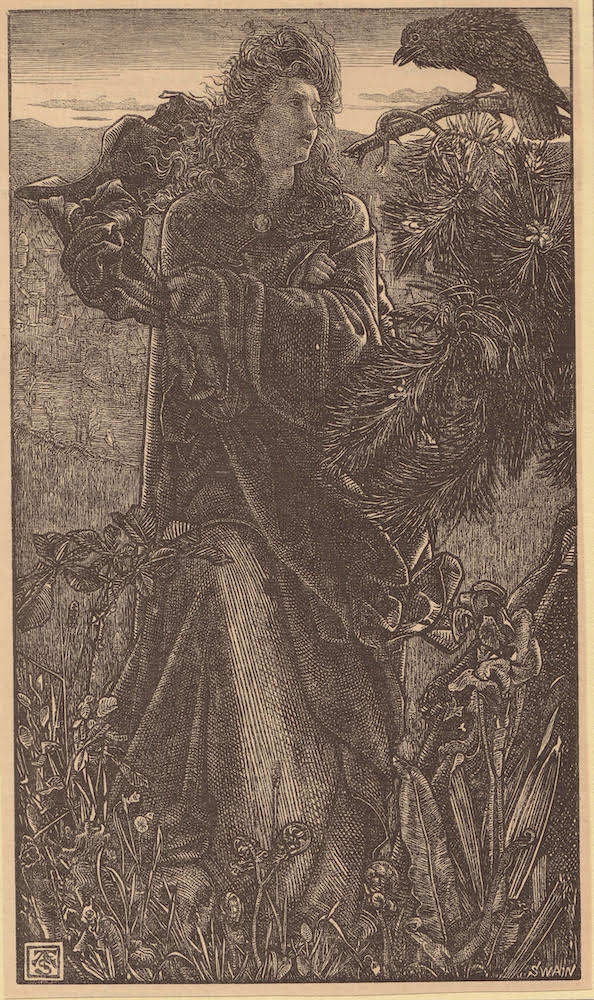

Left: Valkyrie by Frederick Sandys (1829-1904). 1868-73. Oil on canvas. 30 x 15 inches (74.9 x 40.6 cm). Collection of the Williamson Art Gallery and Museum, Birkenhead, accession no. BIKGM:2197. Image courtesy of the Williamson Art Gallery and Museum, reproduced for purposes of non-commercial academic research. Right: Harald Harfagr. 1862. Wood engraving by Joseph Swain after Sandys. 7 ¼ x 4 ¼ inches (18.5 x 10.7 cm). Image courtesy of the author's collection. [Click on the images to enlarge them.]
Betty Elzea describes the painting as: "Full-length female figure facing the spectator with her arms crossed over her breast, holding her cloak and her scarf, which is fluttering around her in the wind. She is dressed in a green cloak with long dark blue skirt below. Her head faces upwards and half to right looking towards a raven perched on a pine branch in the upper right corner of the picture. Her right foot is raised, standing on a human skull. In the foreground are various plants: wild arum, heather, fern, iris, and a young chestnut tree. She is standing on a hill which drops steeply behind her to a river and the walled medieval town on its bank. The scene is either at dawn or sunset, lightning the surface of the river and silhouetting the raven against the sky" (193). The sitter appears to be Emilie "Millie" jones, the sister of Mary Emma Jones.
The design is directly borrowed from an earlier wood engraving entitled Harald Harfagr that appeared in the periodical Once a Week, Volume VII, in August 1862 on p.154, to illustrate a poem by George Borrow. The print illustrates a conversation between a Valkyrie, and a Raven concerning the destiny of the Norse King Harald Harfagr who was killed in the battle of Harfarsafjord in 872 A.D. The Valkyries were powerful maidens who served the god Odin and were linked to fate. Valkyries were sent to the battlefield to choose who will die in battle and to select the bravest amongst the slain who were worthy of entering Valhalla, the hall of slain warriors, where they resided with Odin. These warriors become members of Odin's horde, the Einherjer, who would fight for him in the final battle at Ragnarok. Odin himself had two loyal raven companions and trusted messengers, Hugin and Munin. The Valkyrie were said to have worn raven feather cloaks outside of the battlefield and were sometimes accompanied by ravens during their eternal duties. Ravens were considered travelers between realms based on the belief that they were Odin's eyes and ears. Ravens not only had a symbolic role of wisdom and insight but also had a powerful connection to death and warfare. The sight of a raven or ravens circling overhead during the midst of a battle could be interpreted as an omen. Their appearance in large numbers could signify that Odin was observing the battle and his influence could spell the difference between defeat and victory.
When one compares the finished painting to the engraving minor differences can be noted. The pose of the Valkyrie's head, the handling of her hair, and the folds of her robe and skirt are slightly different. The branches of the pine tree the raven is perched on are more extensive in the print and the plants in the foreground differ somewhat. Details of the town in the background as well as the river and river bank deviate slightly between the two.
The painting was bought after a long gestation by the prominent collector Frederick R. Leyland who hung it on the staircase of his London house at 49 Princess Gate. Leyland was obviously pleased with the final result writing to D.G. Rossetti on October 2, 1873: "I have at this moment received Sandys's Valkyrie after some years of weary waiting. He has made a very fine thing of it – by far the best I have seen of his" (Fennell, 43). Leyland was not alone in admiring it. F.G. Stephens praised the painting when reviewing Leyland's collection in 1882 in his series on "The Private Collections of England" for the Athenaeum:
We conclude here with the fine Scandinavian romance Mr. Sandys delineated and named The Walkyrie [sic]. It comprises the figure of a fierce and stately woman who walks alone on an upland amongst weeds and flowers, undeveloped fern-fronds, and long arms of brambles. A skull is near her feet. A river and a fortress are seen below. Ravens perched on a pine bow whisper in the ear of the mistress of fate the names of those who are to perish in the next combat. Mr. Sandys's poetic insight into the motives of many of the subjects he has affected has been vigorously asserted, and the still and tragic energy of the legend never had better or fitter exposition than in this fine design. A certain metal-like surface and excess of hardness in the textures - defects too frequent in this painter's works - are hardly, if at all, recognizable in this noble instance. [440]
Bibliography
Bate, Percy "The Late Frederick Sandys: A Retrospective." The Studio XXXIII (October 1904): 9.
Elzea, Betty. Frederick Sandys 1829-1904. A Catalogue Raisonné. Woodbridge, Suffolk: The Antique Collectors' Club Ltd., 200, cat. 2.A.110, 193.
Fennell, Francis L. The Rossetti-Leyland Letters. The Correspondence of an Artist and his Patron. Athens, Ohio: Ohio University Press, 1978.
Newall, Christopher. Pre-Raphaelites Beauty and Rebellion. Liverpool: Liverpool University Press, 2016, 81.
Staley, Allen. The New Painting of the 1860s. New Haven and London: Yale University Press, 2011, Chapter Three, "Frederick Sandys,"" 87.
Stephens, Frederic George. "The Private Collections of England. No. LXXI – Galleries in and near Liverpool." The Athenaeum No. 2866 (September 30, 1882): 438-40.
Valkyrie. Art UK. Web. 17 July 2025.
"Viking History. Ravens, Vikings and Norse Mythology." Web. 17 July 2025. https://sonsofvikings.com/blogs/history/ravens-vikings-and-norse-mythology
Williamson, Jonathan. "The role and symbolism of ravens in Norse mythology." The Viking Herald (16 September 2024). Web. https://thevikingherald.com/article/the-role-and-symbolism-of-ravens-in-norse-mythology/1018
Created 17 July 2025